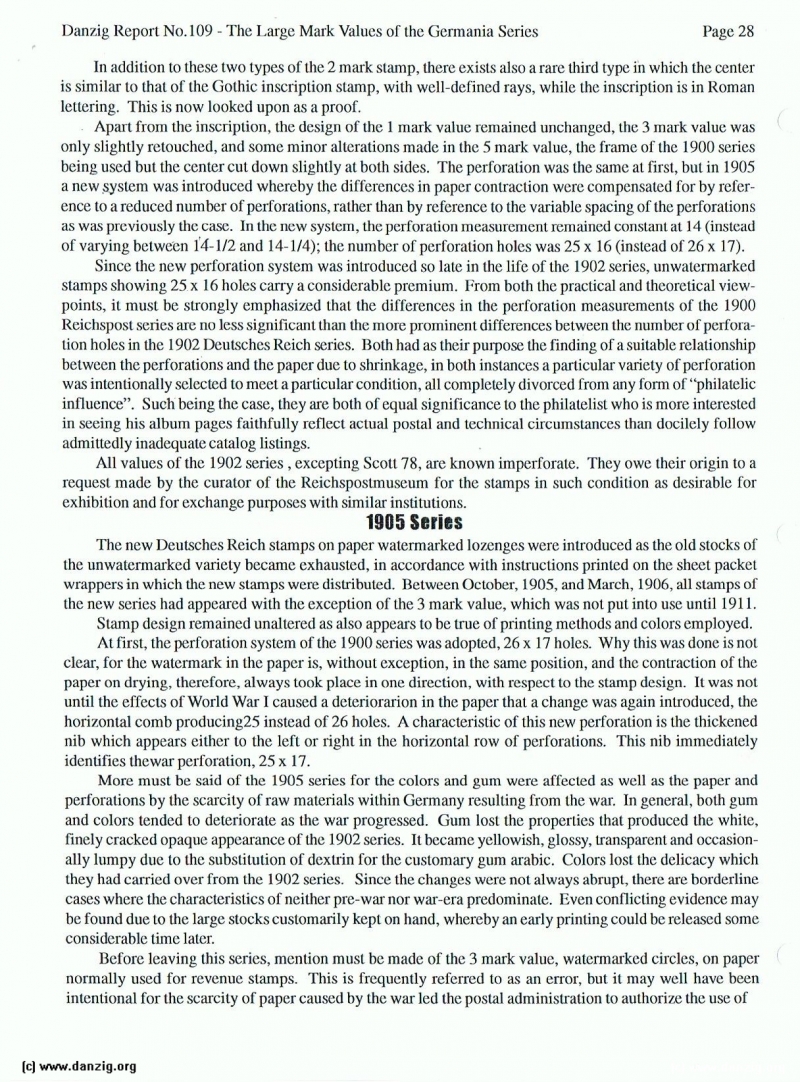
In addition to these two types of the 2 mark stamp, there exists also a rare third type in which the center is similar to that of the Gothic inscription stamp, with well-defined rays, while the inscription is in Roman lettering. This is now looked upon as a proof.
Apart from the inscription, the design of the I mark value remained unchanged, the 3 mark value was only slightly retouched, and some minor alterations made in the 5 mark value, the frame of the 1900 series being used but the center cut down slightly at both sides. The perforation was the same at first, hut in 1905 a new system was introduced whereby the differences in paper contraction were compensated for by refere nce to a reduced number of perforations, rather than by reference to the variable spacing of the perforations as was previously the case. In the new system, the perforanon measurement remained constant at 14 (instead of varying between 14-1/2 and 14-1/4); the number of perforation holes was 25 x 16 (instead of 26 x 17).
Since the new perforation system was introduced so late in the life of the 1902 series, unwatermarked stamps showing 25 x 16 holes carry a considerable premium. From both the practical and theoretical viewp oints, it must be strongly emphasized that the differences in the perforation measurements of the 1900 Reichspost series arc no less significant than the more prominent differences between the number of perforat ion holes in the 1902 l)eutsches Reich series. Both had as their purpose the finding of a suitable relationship between the perforations and the paper due to shrinkage, in both instances a particular variety of perforation was intentionally selected to meet a particular condition, all completely divorced from any form of “philatelic influence”. Such being the case, they are both of equal significance to the philatelist who is more interested in seeing his album pages faithfully reflect actual postal and technical circumstances than docilely follow admittedly inadequate catalog listings.
All values of the 1902 series , excepting Scott 78, are known imperforate. They owe their origin to a request made by the curator of the Reichspostmuseum for the stamps in such condition as desirable for exhibition and for exchange purposes with similar institutions.
1905 Series
The new J)eulsches Reich stamps on paper watermarked lozenges were introduced as the old stocks of the unwatermarked variety became exhausted, in accordance with instructions printed on the sheet packet wrappers in which the new stamps were distributed. Between October, 1905, and March, 1906, all stamps of the new series had appeared with the exception of the 3 mark value, which was not put into use until 1911. Stamp design remained unaltered as also appears to be true of printing methods and colors employed.
At first, the perforation system of the 1900 series was adopted, 26 x 17 holcs. Why this was done is not clear, for the watermark in the paper is, without exception, in the same position, and the contraction of the paper on drying, therefore, always took place in one direction, with respect to the stamp design. It was not until the effects of World War I caused a deteriorarion in the paper that a change was again introduced, the horizontal comb producing25 instead of 26 holes. A characteristic of this new perforation is the thickened nib which appears either to the left or right in the horizontal row of perforations. This nib immediately identifies thcwar perforation, 25 x 17.
More must be said of the 1905 series for the colors and gum were affected as well as the paper and perforations by the scarcity of raw materials within Germany resulting from the war. In general, both gum and colors tended to deteriorate as the war progressed. Gum lost the properties that produced the white, finely cracked opaque appearance of the 1902 series. It became yellowish, glossy, transparent and occasionally lumpy due to the substitution of dextrin for the customary gum arabic. Colors lost the delicacy which they had carried over from the 1902 series. Since the changes were not always abrupt, there are borderline cases where the characteristics of neither pre-war nor war-era predominate. Even conflicting evidence may be found due to the large stocks customarily kept on hand, whereby an early printing could be released some considerable time later.
Before leaving this series, mention must be made of the 3 mark value, watermarked circles, on paper normally used for revenue stamps. This is frequently referred to as an error, but it may well have been intentional for the scarcity of paper caused by the war led the postal administration to authorize the use of
Danzig Report Vol. 1 - Nr. 109 - October - November - December - 2000, Page 34.
Hits: 3697
Added: 29/07/2015
Copyright: 2025 Danzig.org

